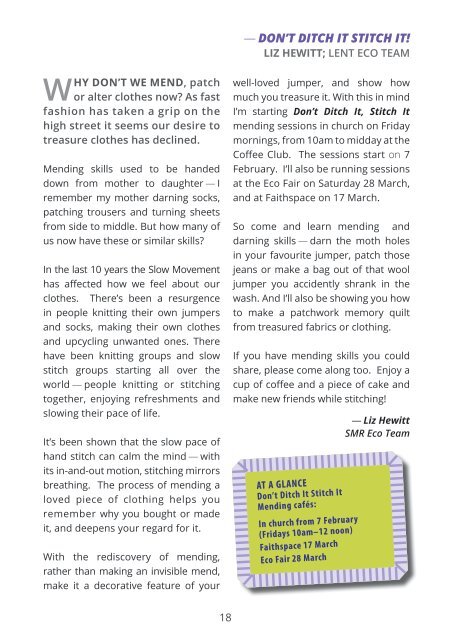St Mary Redcliffe Parish Magazine February/March 2020
You also want an ePaper? Increase the reach of your titles
YUMPU automatically turns print PDFs into web optimized ePapers that Google loves.
WHY DON’T WE MEND, patch<br />
or alter clothes now? As fast<br />
fashion has taken a grip on the<br />
high street it seems our desire to<br />
treasure clothes has declined.<br />
Mending skills used to be handed<br />
down from mother to daughter — I<br />
remember my mother darning socks,<br />
patching trousers and turning sheets<br />
from side to middle. But how many of<br />
us now have these or similar skills?<br />
In the last 10 years the Slow Movement<br />
has affected how we feel about our<br />
clothes. There’s been a resurgence<br />
in people knitting their own jumpers<br />
and socks, making their own clothes<br />
and upcycling unwanted ones. There<br />
have been knitting groups and slow<br />
stitch groups starting all over the<br />
world — people knitting or stitching<br />
together, enjoying refreshments and<br />
slowing their pace of life.<br />
It’s been shown that the slow pace of<br />
hand stitch can calm the mind — with<br />
its in-and-out motion, stitching mirrors<br />
breathing. The process of mending a<br />
loved piece of clothing helps you<br />
remember why you bought or made<br />
it, and deepens your regard for it.<br />
With the rediscovery of mending,<br />
rather than making an invisible mend,<br />
make it a decorative feature of your<br />
— DON’T DITCH IT STITCH IT!<br />
LIZ HEWITT; LENT ECO TEAM<br />
well-loved jumper, and show how<br />
much you treasure it. With this in mind<br />
I’m starting Don’t Ditch It, <strong>St</strong>itch It<br />
mending sessions in church on Friday<br />
mornings, from 10am to midday at the<br />
Coffee Club. The sessions start on 7<br />
<strong>February</strong>. I’ll also be running sessions<br />
at the Eco Fair on Saturday 28 <strong>March</strong>,<br />
and at Faithspace on 17 <strong>March</strong>.<br />
So come and learn mending and<br />
darning skills — darn the moth holes<br />
in your favourite jumper, patch those<br />
jeans or make a bag out of that wool<br />
jumper you accidently shrank in the<br />
wash. And I’ll also be showing you how<br />
to make a patchwork memory quilt<br />
from treasured fabrics or clothing.<br />
If you have mending skills you could<br />
share, please come along too. Enjoy a<br />
cup of coffee and a piece of cake and<br />
make new friends while stitching!<br />
AT A GLANCE<br />
Don’t Ditch It <strong>St</strong>itch It<br />
Mending cafés:<br />
In church from 7 <strong>February</strong><br />
(Fridays 10am–12 noon)<br />
Faithspace 17 <strong>March</strong><br />
Eco Fair 28 <strong>March</strong><br />
— Liz Hewitt<br />
SMR Eco Team<br />
DON’T DITCH IT TREASURE IT! [RECYCLING INFO SHEET]<br />
SMR Eco Team Info Sheet<br />
Liz Hewitt | Recycling Clothes<br />
DID YOU KNOW that according<br />
to the waste charity Wrap*<br />
more than 300,000 tonnes of used<br />
clothing (worth £12.5 billion) goes<br />
to landfill in the UK every year?<br />
It said that 5% of the UK’s total annual<br />
carbon and water waste comes from<br />
clothing alone. Research shows that<br />
on average each person in the UK puts<br />
8 items of clothing in the bin every year.<br />
More than half of those asked said<br />
that the items were perfectly wearable<br />
and that they hadn’t thought to donate<br />
them to family, friends or charity.<br />
After the Second World War people<br />
regularly made their own clothes,<br />
mended and reused clothing, or<br />
passed it on to family or friends. It<br />
was common to “make do and mend”*<br />
As clothing has become cheaper and<br />
cheaper there has been less incentive<br />
to do so. Our culture has shifted to one<br />
where we simply dispose of unwanted<br />
clothes. Today there are more impulse<br />
purchases made, and most households<br />
have items in their wardrobes<br />
that have never been worn. Fifty percent<br />
of people surveyed didn’t think<br />
they could recycle dirty or worn out<br />
garments, and others didn’t know that<br />
clothing can be recycled. So what can<br />
we do? Read on...<br />
DON’T... don’t put wearable clothes in<br />
the bin as they will end up in landfill.<br />
DO...<br />
• Donate unwanted wearable clothes<br />
to charity shops, family or friends.<br />
• Donate damaged clothes: most<br />
charity shops take them — they sell<br />
them on to companies who turn them<br />
into rags, or shred them to make yarn,<br />
paper, insulation or furniture stuffing.<br />
• Swap new and old: some clothes<br />
shops now provide recycling bins, so<br />
when buying a new item leave an old<br />
one behind in one of their bins.<br />
• Donate or sell: to organisations that<br />
ship recycled clothing to Africa or India,<br />
where it is used to create employment<br />
both in recycling and in shredding to<br />
make yarn, paper and insulation.<br />
• Buy second-hand or vintage: find<br />
bargains online and in charity shops.<br />
• Consider the quality of your clothes:<br />
if possible spend more on quality<br />
items that will last, and less on cheaper,<br />
low quality items that won’t.<br />
• Take the Slow Fashion Challenge:<br />
a growing number of people are trying<br />
not to buy new clothes and instead are<br />
buying second-hand, or altering clothes<br />
they already have. Why not try it?<br />
• Treasure your clothes: Remember<br />
that people have worked hard to create<br />
them; that you loved an item enough to<br />
buy it and have enjoyed wearing it — so<br />
if you suddenly find a tear or a hole . . .<br />
darn it or patch it — don’t ditch it.<br />
18 19


















